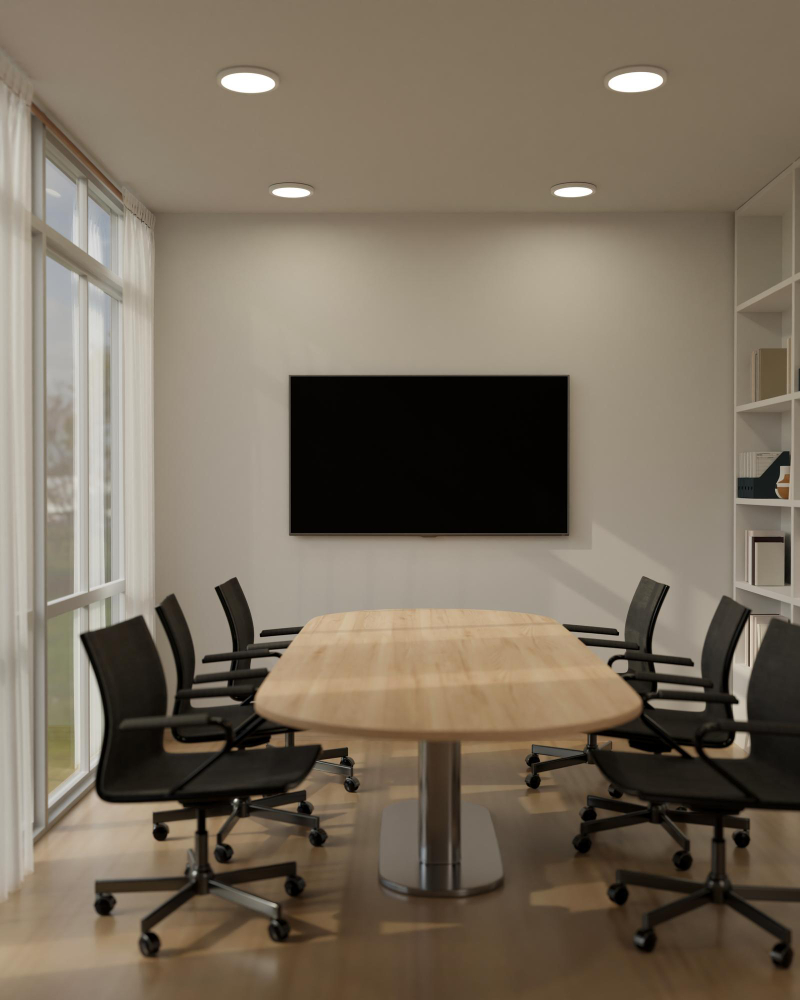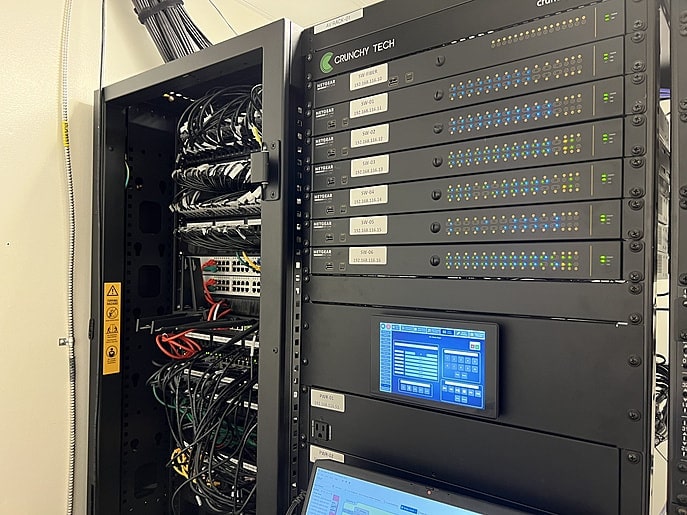The Crunchy Tech Process
As our world becomes increasingly dependent on audiovisual technology, the demand for effective solutions tailored to different environments continues to grow. From bustling offices to dynamic retail spaces and immersive museum exhibits, the need for audiovisual setups that seamlessly blend technology with functionality has never been greater.
In addressing these evolving needs, two primary methods have emerged: Design-Build and Design-Then-Build. In this article, we’ll explore the superiority of the Design-Build approach in delivering optimal audiovisual solutions for diverse spaces, with a specific focus on Crunchy Tech’s innovative methodology. Crunchy Tech, a leader in audiovisual solutions, has revolutionized the industry with its integrated Design-Build approach. But first, let’s distinguish between these two methods to understand their respective advantages and limitations.
Table of contents
The Challenges of Design-Then-Build
Breaking Down Barriers with Design-Build
Cost-Effectiveness and Efficiency
The AV Design-Build Approach
Design-Build is a way of working where everyone involved in a project – like architects, engineers, and construction workers – all team up from the start. Instead of each group doing their part separately, they work together right from the beginning.
This teamwork makes sure that every detail of the audiovisual solution, from the ideas stage to the finished product, is thought about carefully and done well. It also means that if things need to change along the way, it’s easy to adapt without any big hassles.
With Design-Build, there’s no waiting around for different teams to communicate or for decisions to be made – everything happens smoothly and quickly. And because it’s all handled by one team, it’s more efficient, saves time, and keeps costs down for the client.

The Challenges of Design-Then-Build
In the traditional Design-Then-Build process, there’s a clear separation between the planning and construction stages. First, designers at Crunchy Tech create detailed plans and blueprints, outlining how the audiovisual solution should look and function. These plans are then handed over to the construction team, who are tasked with bringing the designs to life.
However, this division between design and construction can present significant challenges. One major issue is the communication barrier that often arises between the design and installation teams. Since these teams typically work independently, vital details may be overlooked or misinterpreted, leading to discrepancies between the initial plans and the final product.
For example, Crunchy Tech’s experts may specify certain technical requirements or aesthetic preferences in the plans. Still, if these details aren’t effectively communicated to the construction team, they may not be implemented correctly. Similarly, the construction team may encounter practical challenges during installation that weren’t addressed in the initial designs.
Furthermore, the separation of design and construction phases limits the opportunity for feedback or input from the construction team during the design stage. This can result in designs that are difficult to implement or require costly modifications, leading to delays and frustration for all parties involved.

Breaking Down Barriers with Audio Visual Design-Build
Revolutionizing Audiovisual Solutions: Crunchy Tech’s Design-Build Approach
Design-Build, as employed by Crunchy Tech, revolutionizes the audiovisual solutions process by eliminating communication barriers and fostering seamless collaboration among designers, engineers, and installers. Unlike the traditional approach, where teams work independently, Crunchy Tech’s Design-Build encourages constant communication and teamwork from start to finish.
Facilitating Open Dialogue: The Strength of Crunchy Tech’s Design-Build Method
One of the key strengths of Crunchy Tech’s Design-Build method is its ability to facilitate open dialogue and shared decision-making among all project stakeholders. By bringing together diverse expertise under one roof, Crunchy Tech’s teams can leverage collective knowledge and insights to address challenges and explore innovative solutions.
Custom Solutions Through Collaboration: A Concert Hall Case Study
For instance, in a recent project, Crunchy Tech’s designers collaborated closely with engineers to develop a custom audiovisual system tailored to the unique acoustics of a concert hall. By collaborating early in the design phase, the team seamlessly integrated specialized sound technologies into the architectural framework, ensuring optimal audio performance without compromising aesthetics.
Cultivating Accountability: The Culture of Crunchy Tech’s Design-Build
Furthermore, Crunchy Tech’s Design-Build promotes a culture of accountability and responsibility, where every team member takes ownership of their role in the project’s success. Installers are involved in the planning and design discussions from the outset, enabling them to anticipate potential challenges and proactively address them before they impact the construction phase.
In summary, Crunchy Tech’s Design-Build transcends traditional barriers and empowers project teams to achieve extraordinary results through collaboration, innovation, and shared accountability. By embracing this integrated approach, businesses can unlock new possibilities in audiovisual design and construction, ultimately enhancing the user experience and driving success.
Cost-Effectiveness and Efficiency
Crunchy Tech’s Design-Build method offers significant cost benefits compared to traditional methods, making it a highly efficient approach for audiovisual solutions projects. One of the primary advantages is the streamlined communication and collaboration inherent in the Design-Build process, which helps to minimize overhead costs associated with managing multiple teams and resolving conflicts between different parties.
Cost-Effective Decision Making from Start to Finish
Moreover, Crunchy Tech’s Design-Build enables project teams to make cost-effective decisions throughout the entire project lifecycle. By involving all stakeholders from the outset, Crunchy Tech’s Design-Build teams can identify potential cost-saving opportunities early on and implement value engineering strategies to optimize project budgets without sacrificing quality or functionality.
Proactive Cost Management
For example, by combining the expertise of designers, engineers, and installers, Crunchy Tech’s Design-Build teams can identify alternative materials or technologies that offer comparable performance at a lower cost. They can also proactively address potential construction challenges during the design phase, minimizing costly change orders and delays during the build phase.
Risks of Fragmented Methods
While it’s true that Design-Then-Build methods may initially appear to offer cost savings by allowing for competitive bidding on construction contracts, these savings may be offset by the inherent inefficiencies and risks associated with the fragmented nature of the process. For instance, delays or errors resulting from miscommunications between design and construction teams can lead to costly change orders and rework, ultimately driving up project costs.
Ensuring Accountability and Project Success
Furthermore, Design-Then-Build projects may be more susceptible to budget overruns and unforeseen expenses due to the lack of integrated project management and accountability. Without a unified team responsible for both design and construction, there’s a greater likelihood of disputes, delays, and cost escalation throughout the project lifecycle.

The Collaborative Advantage
The collaborative culture inherent in Crunchy Tech’s Design-Build projects provides a distinct advantage over traditional methods, fostering a shared sense of purpose, mutual understanding, and collective problem-solving among project teams. Unlike the fragmented approach of Design-Then-Build, where teams work in isolation, Crunchy Tech’s Design-Build encourages open communication, cooperation, and collaboration from the outset.
Alignment of Goals: The Collaborative Strength of Crunchy Tech’s Design-Build
One of the key benefits of this collaborative approach is the alignment of goals and objectives across all project stakeholders. By working together towards a common vision, Crunchy Tech’s Design-Build teams can harness the collective expertise and creativity of architects, engineers, installers, and clients to achieve optimal outcomes that meet or exceed project expectations.
Appreciation for Contributions
The collaborative nature of Crunchy Tech’s Design-Build projects promotes a deeper level of understanding and appreciation for each team member’s role and contributions. Designers gain valuable insights into construction practices, while installers can provide input on design considerations, leading to more informed decision-making and better overall project outcomes.
Collective Problem-Solving
Another advantage of collaboration in Crunchy Tech’s Design-Build projects is the collective problem-solving that occurs when teams come together to address challenges and overcome obstacles.
By leveraging the diverse perspectives and skills of all project stakeholders, Crunchy Tech’s Design-Build teams can identify innovative solutions, mitigate risks, and adapt to changing circumstances more effectively than in traditional, siloed approaches.

When to Choose Design-Build
When considering the approach for your audiovisual solutions project, selecting the right method is crucial for its success. Crunchy Tech’s Design-Build method offers several advantages that make it particularly well-suited for specific project types and scenarios.
Firstly, Crunchy Tech’s Design-Build excels in projects where collaboration, efficiency, and innovation are key priorities. Whether you’re renovating a retail space, designing a cutting-edge museum exhibit, or implementing audiovisual solutions in a corporate office, Crunchy Tech’s integrated approach ensures seamless communication and coordination among all project stakeholders, resulting in superior outcomes.
Ideal For Tight Deadlines
Moreover, Crunchy Tech’s Design-Build is ideal for projects with tight deadlines or evolving requirements. The streamlined process allows for quick decision-making and adaptability, enabling teams to respond swiftly to changes and challenges without compromising quality or delaying project timelines.
Furthermore, Crunchy Tech’s Design-Build method is highly versatile and can accommodate projects of various sizes, complexities, and specialized needs. Whether you’re undertaking a small-scale installation or a large-scale audiovisual integration, Crunchy Tech’s Design-Build teams have the expertise and resources to tailor solutions to your specific requirements, ensuring optimal performance and functionality.
Crunchy Tech’s Design-Build stands as the preferred choice for projects that demand collaboration, efficiency, and flexibility. By embracing this integrated approach, businesses can leverage Crunchy Tech’s expertise to maximize the potential of their audiovisual solutions and achieve outstanding results that align with their unique needs and objectives.
Embracing the Future of Audiovisual Solutions
In conclusion, the Design-Build approach offered by Crunchy Tech presents numerous advantages that make it the superior choice for audiovisual solutions projects. By fostering collaboration, removing communication barriers, and promoting efficiency, Crunchy Tech’s Design-Build teams can consistently deliver exceptional results that meet or exceed client expectations.
Throughout this article, we’ve highlighted the key benefits of Crunchy Tech’s Design-Build method, including its integrated approach, streamlined communication, and ability to adapt to changing project requirements. Unlike the traditional Design-Then-Build method, which often leads to disjointed processes and fragmented outcomes, Crunchy Tech’s Design-Build offers a cohesive and efficient way to bring audiovisual solutions to life.
Choosing the right project delivery method is crucial for the success of any audiovisual solutions project. Crunchy Tech’s Design-Build method, with its collaborative nature and seamless integration of design and construction phases, emerges as the ideal choice for projects where innovation, efficiency, and quality are paramount.
Project Delivery Comparison Table
Design-Build Vs. Design-Then-Build
By embracing the collaborative and integrated nature of Crunchy Tech’s Design-Build, businesses can maximize the potential of their audiovisual solutions projects and achieve superior results that meet their unique needs and objectives.
| Feature | Design-Build | Design-Then-Build |
| Project Delivery Model | Design-Build involves an integrated approach with design and construction phases overlapping, managed by a single entity. | Design-Then-Build follows a sequential approach with distinct design and construction phases, managed by separate entities. |
| Collaboration | Design-Build fosters a high level of collaboration among all stakeholders from the project’s inception. | Collaboration in Design-Then-Build is more compartmentalized, with potential gaps between the design vision and construction reality. |
| Communication | In Design-Build, direct and streamlined communication within a single team enhances clarity and reduces misunderstandings. | Potential for communication barriers between separate design and construction teams in Design-Then-Build can lead to project delays and increased costs. |
| Project Efficiency | Design-Build offers greater efficiency due to concurrent design and construction activities, leading to shorter project timelines. | Efficiency in Design-Then-Build can be compromised by the need for bid processes and handover between design and construction phases. |
| Cost Management | Design-Build enhances the ability to manage costs throughout the project, with more accurate budgeting and cost savings through value engineering. | Costs in Design-Then-Build can be less predictable, with potential for budget overruns due to changes in scope or unanticipated construction challenges. |
| Flexibility and Problem-Solving | Design-Build provides increased flexibility to adjust during the project, with immediate problem-solving by the integrated team. | Less flexibility for changes once the project moves from design to construction in Design-Then-Build can potentially lead to costly modifications. |
| Quality and Innovation | Design-Build encourages innovative solutions and high-quality outcomes through the close collaboration of designers and builders. | Innovation and quality can be constrained by the separation of design and construction expertise and insights in Design-Then-Build. |
| Overall Project Success | Design-Build projects have a higher likelihood of success, with a unified team working towards common goals and a shared vision. | Success in Design-Then-Build depends on effective coordination between separate entities, which can introduce risks and challenges. |
Upgrade Your AV Projects with Crunchy Tech AV Solutions!
If you’re looking to transform your space with cutting-edge technology, we strongly urge you to get in touch with Crunchy Tech. Our expert team is ready to tailor solutions to your needs and exceed your expectations.
Contact us today and let’s elevate your space together!
